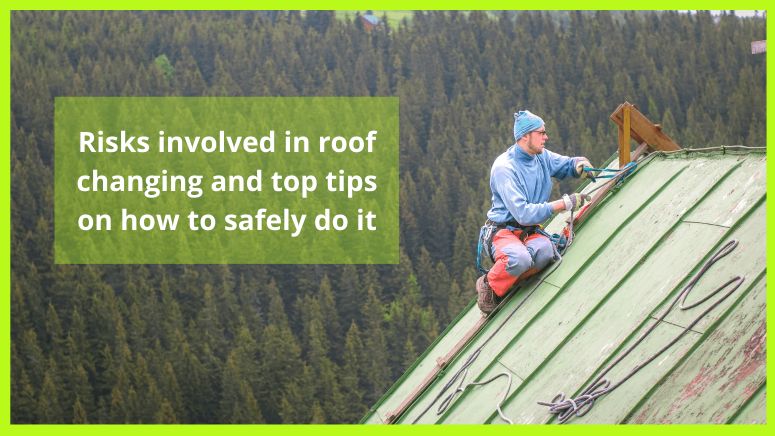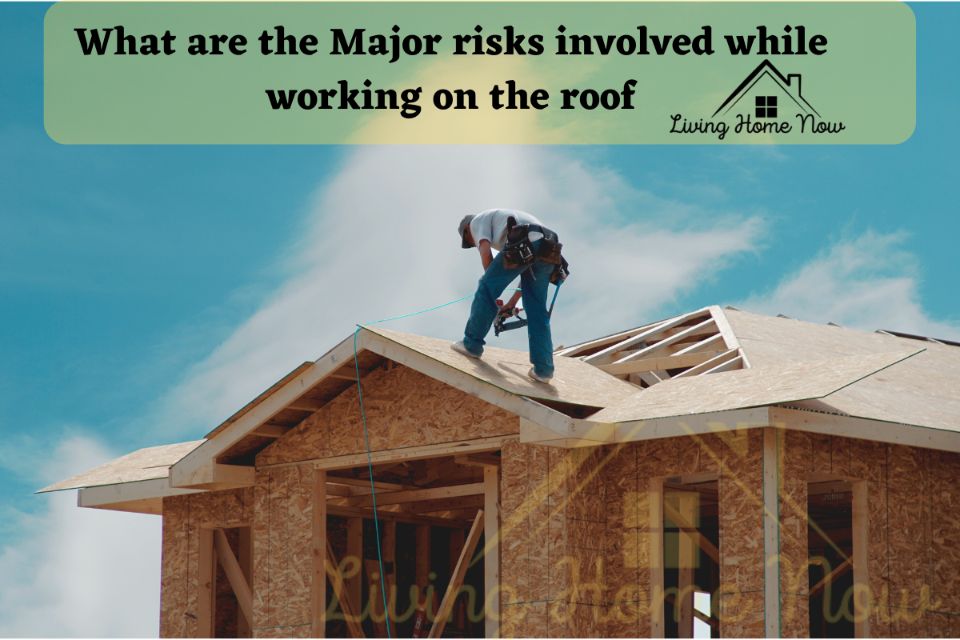Sometimes you may have to change the roof tiles, fix your gutters, change your roof entirely or paint your roofs. In some cases, such as hailstorms, the roof tiles of your home can be damaged, requiring you to make an urgent repair to avoid problems with leaks inside your home.
Even if it is to replace just one tile, doing those small changes can be difficult if you don’t take certain precautions to avoid getting hurt. Sometimes, a fall can result in serious injuries, which may even be fatal. Therefore, it is essential to be alert to avoid accidents and follow some specific rules and guides.
Climbing up onto a roof is a dangerous endeavor, so you should hire a qualified professional. However, This article will guide you on risks involved in roof changing and how to do it safely.
Table of Contents
What are the major risks involved while working on the roof?

On a roof, climbing cannot be done without proper equipment and is potentially very dangerous. Since there are many risks involved, these kinds of tasks are always performed by professionals. Therefore, it would be best to always let a professional handle your roofing work since they are experienced with handling risks and safety issues.
A fall from a ladder
There is a high risk of falling from the ladder during roof repairs rather than from the roof itself. So before climbing the ladder, make sure it’s stable.
Falling through the roof.
The risk of falling through the roof is even more significant when climbing on an old or damaged roof since you can fall not just off but also through. Don’t put too much weight on your roof. It can easily bend under your weight if it is damaged.
Falling objects.
We mustn’t overlook this risk, which directly affects the people on the ground. For example, when a tool or tile falls, the person who receives it on the head could suffer severe discomfort.
Any fall associated with roofing work, whether through the roof, on the roof, or from the roof, is extremely dangerous. They can damage your body permanently or even kill you. For this reason, you should follow safety guidelines and precautions if you want to do roofing work yourself instead of hiring a professional.
How to safely roof a house without any hazards:
It is important to know, how to change roofs safely by marinating some precautions. So,we have separated the precautions you need to take when working on the roof.

1. Have the right equipment
If you are going to do any roofing work, you need to make sure you have the right tools. First, ensure you choose a ladder that is appropriate for accessing the roof. Ideally, the ladder should be able to reach at least one meter above the gutters.
To accomplish this, you can either buy a roofer’s ladder or install stabilizers on your ladder. Then, secure it to an anchor point, preferably a stable support (not the gutter).
It is essential to understand that ladders are only for climbing to the top of the roof; they are not even meant to clean gutters. When safety and comfort are paramount, a scaffold is essential if the roofing project will last several days. It is necessary to use a nacelle when you have a high or sloping roof (possibly renting one) to keep yourself safe.
2. Climb carefully
It is imperative to be very careful when climbing on the roof of your house from the very beginning. Therefore, there is no need to improvise.
Additionally, you should avoid climbing on the roof if the tiles are damp. Because of this, you are more likely to have an accident there. So, you should always ensure that the roof site is completely dry before you continue with the installation to maintain your roof.
3. Don’t forget to check the fixings
Another critical thing to remember about roof walking is to keep an eye on all the fixings. In areas with strong winds, they serve to keep the shingles from shifting or being blown off. However, due to dried rubber, fixings sometimes loosen over time or even lose their seal.
As a result, it is important to perform preventive maintenance, remove damaged fasteners, and replace rubbers as soon as possible. If you apply this to your roof, it will enhance your sense of safety and comfort during the renovation or repair of your home!
4. Provide a board
Avoid walking directly on the shingles of your roof during a construction project to ensure more safety. If you do this, you will prevent possible problems with drips in your house and accidents during the renovation.
Fortunately, you can use a board that gives you access to your roof while still preserving the integrity of your shingles. By doing so, you will be able to lessen the impact of your weight on the shingles and have more firm ground to move on.
5. Wear well-fitting shoes with appropriate soles
Whenever you perform roofing work, it’s essential to use the right equipment to ensure your safety. Wearing well-fitting shoes to your feet is therefore essential. As a result, your shoes give you more excellent stability while walking on the tiles and keep you from falling.
Choose shoes that have soles that are appropriate for the type of work that you will do. Rubber surfaces on non-slip models prevent you from slipping and causing an accident while working.
6. Make sure your ladder is in good condition
You should at least make sure that you can reach your roof safely before considering how to walk on it. You need to consider a few things before you start working on your roof.
Check first whether your ladder can support your weight. Usually, these kinds of information are available on the tool’s sticker. After this, it is vital to inspect the machine’s condition to ensure no loose or damaged parts.
Under no circumstances use a broken ladder. Make sure no breaks or loose parts are present on the ladder. Ensure the ladder is not broken and that there are no slippery substances on the rungs, such as oil or grease.
7. Check the positioning of the ladder
As you climb on your home’s roof, you have to have a ladder strategically positioned. The problem is that if you position the ladder incorrectly, you will not have enough stability to reach the roof safely, and you may fall.
To steady the ladder:
- Find a solid and flat surface.
- Put the ladder’s feet on dirt or grass instead of concrete since some ladder models do not have rubber feet to prevent the ladder from sliding around.
- Make sure the top rail is not close to wiring or other dangers before lifting it.
Position the base of the ladder at a distance of about ¼ of the height of the wall from your house. Never climb beyond the 4th or 5th rung from the top of the ladder, and do not tie yourself to the ladder.
8. Ensure essential safety harness, Wear proper protective equipment
Falling can be fatal, so you must wear a safety harness. Providing complete fall protection is possible through the rental of a kit. When putting on the harness, make sure it is the correct length and adjust it if necessary. It would help if you never placed the back loop at the neck; instead, place it in the middle of the back, between the shoulder blades.
At the thighs, adjust and close the straps. After the straps are clipped, a feeling of tension should emerge between the shoulders and the thighs. The tension in the harness should keep you from slipping out of place, but you should still be able to place your fingers between yourself and the harness.
You should wear non-slip shoes, a helmet, sunglasses, and long-sleeved shirts in addition to non-slip shoes. When you are on your roof, you will be in direct sunlight, increasing your risk of heatstroke.
Although the weather may be cloudy, the dullness can still burn your skin. So don’t forget to apply sunscreen to your face as well.
Make sure you have a carpenter’s belt. Then all your tools will be right at your fingertips, so you won’t have to leave them lying around on the roof. You will also be less likely to drop anything. Ensure that everyone on the job site wears a helmet, work clothes, non-slip shoes, and non-marking footwear.
9. Keep your workspace clean and keep an eye out for hazards
Lastly, for you to walk on a roof in complete safety, you must always keep your work site clean and observe the surroundings so that you may be aware of potential hazards.
By doing this, you’ll be able to compensate for any injuries you might sustain due to your work. Aside from that, avoid working in extreme conditions, like rain and hail, as well as high temperatures. These factors significantly increase the risk of equipment damage or accidents.
10. Never work alone
If you are going to work on your roof, do not do so alone or without notifying anyone beforehand. Working in pairs is essential for several reasons:
During a fall, you might not be able to notify rescuers. However, the person by your side should be able to call for help if you fall, so that if something were to go wrong, they could call for assistance.
If the ladder slips, someone who will be with you on the job can hold its legs.
It is easier if you have someone to help you carry the material and pass it to you so that you do not have to climb up and down the ladder continually.
However, don’t climb a roof with someone you aren’t familiar with. There isn’t enough strength in the roof to support several people.
11. Weather conditions should be considered
It is extremely important to take into consideration the weather when working on the roof. During rain or after recent rain, your roof will become slippery and unpassable, so you should not climb on it when it is raining. Also, when the wind blows, you can lose your balance and tip over.
In addition, you should keep in mind that the wind is stronger on a roof than it is on the ground. Therefore, take no chances and do not get on your roof in windy weather. Last but not least, the sun is also not your ally. For maximum comfort and to prevent sunstroke, work early in the morning or late in the afternoon.
12. Check the condition of the roof before you climb
Check the roof with your hand to see if it is slippery. Check for mold, algae, or water, which will cause you to slip. If it is smooth, try the repair another time.
Final:
Climbing a roof should not be taken lightly. In the construction industry, falls from height are responsible for 17% of accidents. By following these steps on how to roof safely, you will be better prepared when it comes to performing maintenance or renovation of your roofs, eliminating fears of potential dangers.